Mattie Silks, or Martha Ready (1848-1929), was a leading madam and brothel keeper in the latter part of the 19th century.
Early life
Born in Fayette County, Pennsylvania, raised in Indiana, Silks began her working career in Springfield, Illinois. She was one of the best known madams in the west, having brothels in Dodge City, Kansas and Denver, Colorado, where demand for women was high due to the Colorado gold rushes.
Other stories say she was born in Kansas - had enterprises in Fairplay, Colorado -
You might look for her character in the Sharon Stone/ Gene Hackman / Gary Sinesi movie "The Quick and the Dead" The minister in the movie is even named "Cort." One scene - a wedding in Mattie's saloon - was cut. It had the only cameo appearance by Bruce Campbell.
" The following, published in the Rocky Mountain News on March 3, 1881, described the memorial service for Mattie Woods who died in a parlor house at 500 Holladay Street, run by Mattie Silks. All that was mortal of Mattie Woods, the poor cyprian who ended her life on last Monday night, was laid away to rest in quiet, peaceful Riverside yesterday afternoon. The obsequies were conducted from Brown’s undertaking rooms on Lawrence Street, and were of a simple and unostentatious nature. The rooms were thronged with friends who had known the dead woman during life, and there were many kind words of love and pity spoken. Cheeks which have long forgotten a virtuous blush were tear-stained and many painted lips were parted in silent prayer for the repose of their erring sister’s soul. Twenty women in all were present, and their sincere grief seemed to soften and lessen their social sins to the few spectators who had been attracted to the scene through curiosity. The coffin stood near the center of the room and bore a burden of floral offerings. At the head was a large wreath and cross of sweet immortelles and bouquets were arranged about for the foot. Within, the tired body rested, and the face looked pure and almost saintly. The burial robes were of a rich and appropriate texture and in fit keeping with the perfect arrangements for the last sad rites so commendably prepared by the women who provided them."
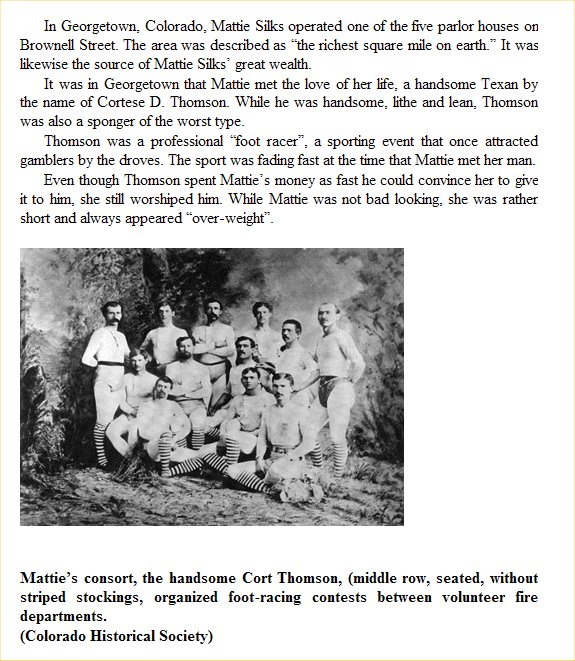

One neighbor, Art Armstrong, had the HX brand, and another, Thomas Ashton, had the HVV. Cort registered for the HXX brand ! You can imagine the accusations.
(The Rattler on February 1, 1902 referenced "the old Armstrong ranch east of town." - The 1900's references to the "Ashton Ranch" placed it east of Laird)
One Yuma person said "The Thompson's always sold more livestock than they raised."
Other expressions:
"Their cows always had twin calves.".
"They work best at night.".
"Dragging the long rope"
Maverick Factory - A herd of cattle that increases faster than any normal rate of reproduction -- usually with a high percentage of suspicious-looking brands
Mattie discharged the foreman, known locally as Dirty Face Murphy, and hired in his place Jack Ready, a tall and handsome mountain of a man.
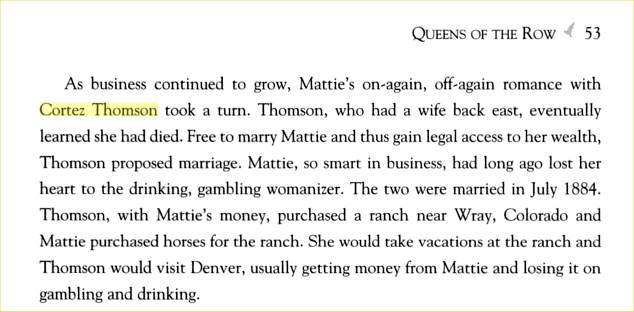
| Name: | Martha A Silks |
|---|---|
| Spouse Name: | Cortez D Thompson |
| Marriage Date: | 6 Jul 1884 |
| Marriage County: | Miami |
| Source Title 1: | Miami County |
| Source Title 2: | Index to Marriage Record 1850-1920 Inclusive |
| Source Title 3: | Original Record Located County Clerks Office, Peru, INDIANA |
| Book: | C 7 |
| OS Page: | 268 |
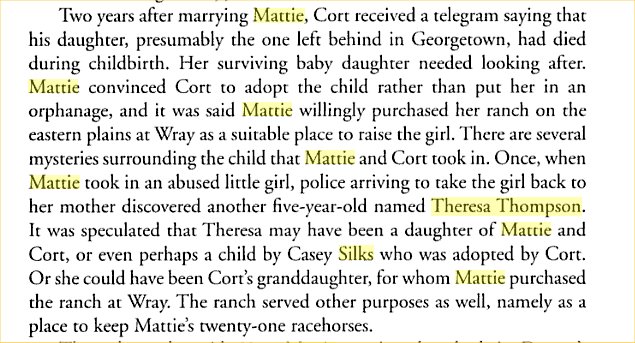
Cort loved horses, obviously. He gave Sam Shafer this rocking horse.
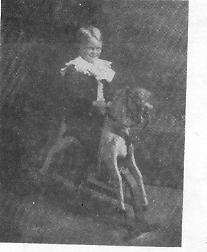
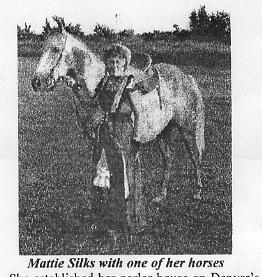
Harry Arthur Gant writes
The Denver Voice wrote in August 1998 "Mattie Silks and her main competitor Jennie Rogers were
the Abbott and Costello of the oldest profession
in turn-of-the-century Denver. Mattie was short and stout,
dainty, and was never without her diamond-encrusted crucifix.
Jennie and Mattie were both successful businesswomen in an
age when other frontier careers - miner, cowboy, gambler
were closed off to their sex.
Jennie, tall and elegant, wore emerald earrings.
She advertised by riding along with her girls behind
four beautiful horses.
Jennie arrived in town in 1879, three years after her
friend Mattie. She built her notorious House of Mirrors at
1942 Market by blackmailing an Eastern politician,
and the five carved faces sculpted over the door
immortalized the players in that little drama.
The house was soon sold to another Madame, Ella Bowser,
who never stopped loving the husband she had abandoned.
When she learned that he had remarried happily,
Ella exclaimed, "I too am happy. O! I arn so happy!
So happy that I'll blow my goddamned brains out."
Blood spattered her pearl necklace and the person
of her bedmate William Prinn,
deputy Clerk of the County.
Jennie's new place was just a few blocks from the
State legislature, and the elected officials passed by
David Mechling's drugstore on their way to her bordello.
"Each afternoon about three o'clock the august
lawmakers would retire to Jennie Rogers' on Market
Street and there deport themselves in riotous fashion,"
the druggist narrates in historian Clark Secrest's
book Hell's Belles.
" Nothing was thought of that sort of thing in those days.
It was a time of hard living. Men took their liquor neat
and women took what they could get their hands on."
"Where were the cops?" I hear a gentle reader asking.
The Denver Police Department, eighty men strong in the
1890's, smelled of whiskey and corruption.
Cops drank on duty, stole money from the prisoners
they had beaten, provided protection (for a fee) and
donated money to the Democratic party.
Politicians too depended on the tourist dollars to
subsidize their careers, and though vice might not
be nice, it did bring in the bucks.
A brothel inmate voted well, and often,
on election day. The head of the Denver Fire and
Police Board and future Mayor, Robert Speer,
replied to all those who wished to clean up Denver:
"It can hardly be expected that the fire and Police
Board can do in a short time what other boards and
governments have failed in. As far as I am concerned,
I do not approve of a change in policy."
That policy segregated the red-light district to a few
blocks around Market and 20th. Most of the prostitutes
did not ply their trade behind thick curtains, to the
music of a player piano in fancy parlors. Instead,
they propositioned men from open doorways and windows,
often grabbing their hats to lure them in...
if the client was lucky, he got a quickie without
losing his wallet or his life.
The poorer prostitutes of upper Market depended
on their Macs to protect them, and drugs blotted
out the pain. Opium, cocaine and imarijuana were
still legal, and many were the women of upper Market
who chose to end their lives with an overdose of
medicine. And the money kept rolling in."
"A buckboard slithered in from Court Thompson's ranch,
north of the river. Madam Mattie Silks sat on the front seat
with the driver. The back seat held a being, 'Beauteous,'
a sad little lady. A great picture hat topped her dusky
pompadour, her dress was of shiny blue satin.
Gentian eyes, dark fringed, were blank as a sleep walker.
The buckboard stopped at the porch at Fred Careys where
Uncle Billy and little Nell sat lost in quiet meditation.
The Being alighted and paused a moment to lay a white hand
on the head of the strange little child of the prairies.
Nell stood with bowed head in dumb admiration.
When the buckboard returned across the sunny sandhills,
little Nell turned and asked Uncle Billy.
'Who was that lovely lady, Uncle Billy? Was she a princess?
She looked like an angel.'
Uncle Billy spoke slowly. 'Angels are of many kinds,
perhaps she is one of God's fallen angels. Let him who is
without sin cast the first stone at her. Folks here
in Laird call her one of Madame Silks overworked Jezebels.'
The child smoothed the folds of her blue pinafore;
her lips quivered. 'No one would throw stones at such a
lovely lady,' she said. 'Uncle Billy do you suppose
that if I study hard and do as Miss Belle wants me to,
that some day I might get to be a lovely, lovely Jezebel?
Uncle Billy I want to be one. I want to wear a dress the
color of the sky, just as she does. What is a Jezebel,
Unde Billy?'
Uncle Billy spoke with great wisdom, 'Folks who take
love that is not their own, gathers a flower
with poison on its petals. The poison makes you a
Jezebel.'
She lifted her eyes to his face. 'Are the poisoned
flowers always so lovely?' She asked him.
The old man smiled, 'They are always lovely,'
he murmered. "
-------------------------------------------------------------------------------------------------------------------------------------------------------------------
Cort Thomson acquired a piece of land in 3 N 42 W in 1890 via a Cash Claim, another in August 1895 (160 acres in a strip across sections 4 and 5) via Homestead, and an additional piece (the north one-quarter of section 8) in June 1895 via a Timber Claim. So "Cort" acquired land from the government in three different ways. If anyone is in Washington, D.C., it would be interesting to see the applications for each of those. AND for "Mattie's" homestead application a few years later.
That's about 15 miles straight north of Laird, Colorado
If you look at the Township Map you'll see a little pond - so that area likely had exceptionally available water for livestock. Raymond "Pat" Workman wrote that in 1938 "we moved to a ranch a half mile south of where the Thompson lake used to be." - so it was an intermittent pond.
All the land in that township was acquired by BLM transfer, and I didn't see any prior to 1890. Mattie may have bought livestock and Cortez ran them on open range.
That township is partly in Colorado, and part in Nebraska (Dundy County). On the Nebraska side, there are no land patents prior to 1903 in the BLM records. So the Thomson ranch likely grazed cattle on open range even across the state line.
|
||||||


One blogger wrote "Ella Wilson was a prostitute in Skagway who worked for
Mattie Silks at the Red Onion. She was strangled to death not long before Soapy
Smith was shot, and Mattie Silks claimed to overhear through the wall of a room,
Soapy and his men dividing up the three thousand dollars that was stolen from
the poor girl's crib. Silks was convinced that Soapy had done the murder"
One of the local wags--shortly after the memorial to Frank Reid was erected with
its famous epitaph "He gave his life for the honor of Scagway"--scribbled on
Ella Wilson's marker, "She gave her honor for the life of Scagway."
Jeff Smith, writing about the Yukon trip, claims "There is no doubt that
Ella Wilson was murdered. The newspapers claimed it was a robbery gone all
wrong. Ella was found tied up and gagged, with a pillow cover over her head.
She had suffocated. I can't go into great detail as all this information is in
my book, yet to be published, but I will tell you that madam Mattie Silks knew
Soapy in Denver Colorado. Smith and Silks were not on good terms with each
other as each backed opposite city politics. Her husband Cort, a backer of
Jeff's rivals had been involved in a saloon gunbattle that Soapy participated
in. Shots were fired from several guns and one man fell dead. Cort was arrested
for the murder but aquited. blames finger pointed in all directions. Years
later a good friend of Soapy's good friends hinted that it was Soapy who had
fired the deadly round.
In 1898 Cort and Mattie decided to set up her gentlemanly goods (prostitution)
shop in the Klondike. Business reasons sent Mattie to Skagway, but Cort stayed
clear of the town due to Soapy. It was at this time that Ella Wilson was killed
and robbed. Mattie left Skagway and did not tell her story until she reached
Seattle, out of the long grasp of the soap gang.
Mattie claimed she heard Soapy, the U.S. deputy marshal, and others talking
about Ella and the money, and that Soapy told his men to go after Mattie next.
"Up in Alaska among the rocky cliffs overlooking Skagway is a unique memorial
to another Smith. It is a rocky profile of heroic size,
naturally shaped and painted white to resemble a skull and bearing the words
Soapy Smith's Skull. Thus does Skagway memorialize Jefferson Randolph Smith.
Its mayor and boss in the roaring days of the Klondike gold rush,
and one of the most picturesquely villainous figures in frontier history.
A native of Georgia, Smith was a gambler in vatious Coloiado mining towns,
a con man of the first water (his nickname of Soapy coming from one of his
schemes of fleecing the suckers with cakes of soap wrnpped in $20 bills),
and later the king of the Denver underworld. When he went to Alnska he
became the big man of Skagway, but his high handed methods soon got him into
trouble. Theie was talk of vigilante methods to rid the town of him,
but Tiank Held, an engineer, saved tbem the trouble. Soapy tried to bluff
Heid, but Reid couldnt be bluffed. A bullet from his gun put an end to
this most famous bad man of the last frontier."
1898 Sterling

![]() Wray Rattler October 1898 (either Mattie returned from the Yukon - or she
"planted" newspaper stories to keep residency for homesteading purposes
Wray Rattler October 1898 (either Mattie returned from the Yukon - or she
"planted" newspaper stories to keep residency for homesteading purposes
November 4, 1898 "Mrs. C.D. Thompson received a telegram from her husband in California saying that he was on his way to Haigler. It will be remembered that he was reported lost at sea while on his way to the Alaskan gold fields. - Haigler Items in Benkleman Chronicle."
 Yuma Pioneer of August 1899
Yuma Pioneer of August 1899
October 1899 "C.D. Thompson is building cattle sheds. Charlie Vaness and Lone Rife are doing the work."
 Wray Rattler November 4, 1899
Wray Rattler November 4, 1899
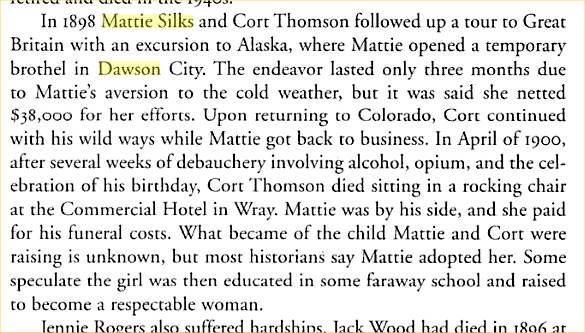
 January 1900 (Literally, to be sent to the countryside )
January 1900 (Literally, to be sent to the countryside )
 Rattler October 1899 (so he must live near Laird) He opened a barber
shop later that year
Rattler October 1899 (so he must live near Laird) He opened a barber
shop later that year
![]()
![]() Rattler - February 1900
Rattler - February 1900
 Yuma Pioneer April 1900
Yuma Pioneer April 1900
The Rattler's April 7, 1900 reported that "Mrs. C.D. Thompson was down from Denver Thursday and Friday on business connected with the ranch." (That would have been April 5th and 6th.This was a front-page item, not one from the Laird correspondent)
The same issue, in the Laird column, said "Perry Burns of Denver was visiting at the Thompson ranch."
and that "C.T. Grant of Wray was overseeing work on the race track, which was completed recently."

 Yuma Pioneer April 13, 1900
Yuma Pioneer April 13, 1900

The Wray Rattler - Saturday, April 14, 1900 -
Cort D. Thomson is dead. He came up from his ranch Friday night, suffering with acute pain which developed into pneumonia and 10:50 Wednesday morning (that would be April 11) he passed away. He was attended by his wife during his illness, and she accompanied the remains to Denver on the1:50 train the same day. A nephew of the deceased has taken charge of the ranch. Cort was a heavy drinker and it is said that on account of the ravages made by the whiskey that he was unable to successfully cope with the disease.
If the April 7 Rattler story is right, Mattie was in time to take Cort to Wray.
Another version says that Mattie suspected Cort was going to sell her horses (he was in financial difficulty) and had come to prevent that. This version said Cort developed ptomaine from eating spoiled oysters, and died at sunup April 12 at "Grandma Simpson's" hotel
The latter story might be supported by the Rattler of a WEEK later - Saturday April 21, 1900
![]() That
would be April 14 - if it's correct, Mattie took Cort's body to Denver on
Wednesday, and came back to Wray on Saturday to take care of business.
That
would be April 14 - if it's correct, Mattie took Cort's body to Denver on
Wednesday, and came back to Wray on Saturday to take care of business.
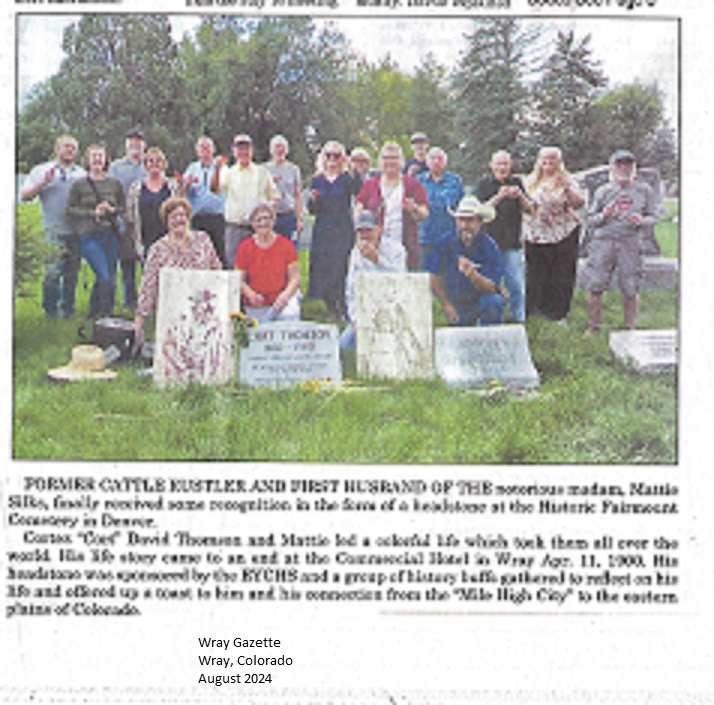
The following week's paper reported that John Brown had bought the C.D. Thompson
cattle.
Cort died before the 1900 census - but Mattie reported her residence as Yuma County (the people before and after her were residents of Laird, so she was either living in the town or had someone there give the census-taker the information !)
In August 1900 the Yuma Pioneer reported: 
Martha A. Thompson, born in Pennsylvania of Pennsylvania parents in April 1845. Widowed,
with Theresa Thompson, niece, born January 1890 in Colorado with a Pennsylvania father and Missouri mother.
AND Mattie Silks - under that name, is in the 1900 census for Denver - head of a household on Market Street, born in New York, with eight young single female boarders with no occupation. The names and places of birth given the census-taker sure look contrived.
So she maintained two personae ?
 Pioneer June 1901
Pioneer June 1901
 Rattler
July 1901
Rattler
July 1901
 Rattler February 15, 1902
Rattler February 15, 1902
Jack might be the J.P. Ready charged with intoxication in Denver Magistrate Court in October 1903.
 Gazette
March 1905
Gazette
March 1905
 Rattler
March 1905 - This is the Jack Ready that Mattie later married.
Rattler
March 1905 - This is the Jack Ready that Mattie later married.
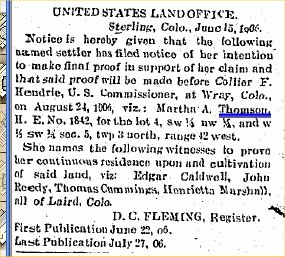 Rattler June 1906 - and maybe he also was a witness....
Rattler June 1906 - and maybe he also was a witness....

 Rattler March 1905
Rattler March 1905
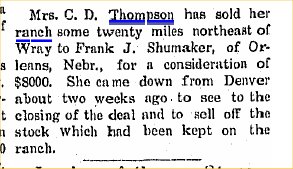 Rattler
December 1906
Rattler
December 1906
 Mattie
must have put some livestock in her niece's name - Rattler February 1907
Mattie
must have put some livestock in her niece's name - Rattler February 1907
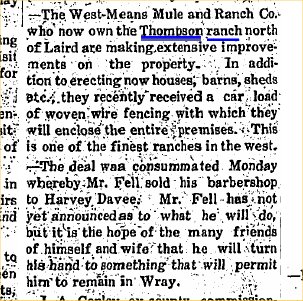 Rattler September 1907
Rattler September 1907
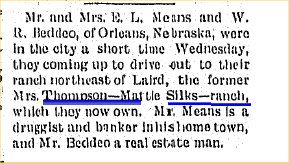 Gazette September 1907
Gazette September 1907
 Rattler March 1909
Rattler March 1909
 Rattler April 1909 (guess it was still called the Thompson ranch....)
Rattler April 1909 (guess it was still called the Thompson ranch....)
 Rattler January 1913
Rattler January 1913
 Rattler October 1913 - this is from an area north of Wray, not Laird. So
there was no phone service to the ranch at that time.
Rattler October 1913 - this is from an area north of Wray, not Laird. So
there was no phone service to the ranch at that time.
 Rattler March 1914
Rattler March 1914
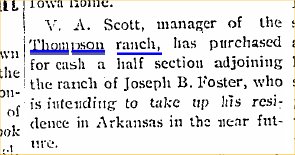 Rattler March 1914
Rattler March 1914
 Rattler June 1914
Rattler June 1914
 Rattler December 1914
Rattler December 1914
 Rattler May 1917
Rattler May 1917
 Rattler October 1917
Rattler October 1917
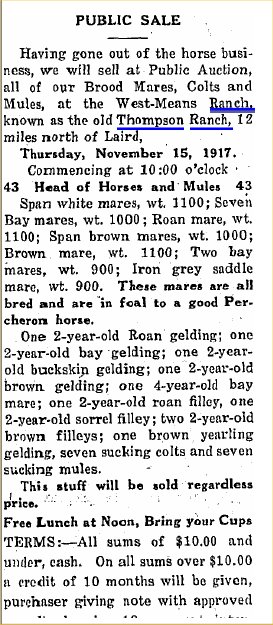 Rattler
December 1917
Rattler
December 1917
She also hired a man named Jack Ready to be her new financial advisor, as well as bouncer. Mattie was lonely and in search of companionship, and so it wasn't long before the two were intimately involved. They spent many years "dating" and becoming best of friends. In 1923, at the age of 77, Mattie said "I do" and married "Handsome" Jack Ready.
The ceremony was performed by G.A. Schmidt, a minister, in Denver May 1, 1923. The names on the marriage record are John Ready and Martha Thomson.
| Mattie's third husband John (Handsome
Jack) Ready died May 23, 1931. He is buried about one block
north of Mattie and Cort."
|

"The Rocky Mountain News in 1928 interviewed the notorious Denver Madam Mattie Silks, one last time at the age of eighty-two. Historian Secrest writes that the reporter remembered her talk with Mattie, which was left unpublished by a paper become too prudish for honesty: “She smiled kindly at us (the reporter and photographer) as we left. There may have been a little contempt in her smile and I felt there was - but it was good humored contempt mixed with a little pity - the look of a woman who believed she knew a great deal more about this world than we did. It was with a definite feeling of disappointment I left the premises and not without a certain amount of scorn.
For I asked myself 'What right had that old woman to have a crucifix over her bed? To be lying there so sweet and clean and serene when so close to her end? - and to have caused me for a few minutes actually to like her?' Mattie died a few months later in 1929, and was buried beside her lover Cort Thompson in Fairmount Cemetery. Close by was Jennie Rogers, who had died two decades earlier, next to her true love and shooting victim. Jack Wood."
Wonder if he's related to the John P. Ready in the Denver divorce case in 1931 - the other party being Olive V. Ready. This John is younger, born about 1898.
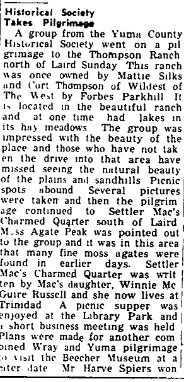 June 18, 1959 Yuma Pioneer
June 18, 1959 Yuma Pioneer

Theresa Thomson in 1906 and 1907 had the K7 brand registered to her (the newspapers publish them, like other legal notices.)
In the 1910 census, Theresa Thomson, born in 1888, is head of a household on Market Street in Denver, with a 48-year-old servant and nine female boarders with "own income."
It's possible she's the lodger in 1920 on Clay Street in Denver in the John Thomas household. John is 48, a self-employed auto express driver, and his wife is 46. Seem old to have a seven-year-old son.... Theresa is single, 29, born in Colorado, and is a laundress (very common to give that occupation to census-takers).
According to one Ancestry member, she married James Aaron Johnson April 19, 1924. and died in Goldendale, Kickitat County, Washington.
| Name: Theresa L Johnson Date of Death: 3 Dec 1967 Klickitat Certificate: 028177 |
|---|
If she's the same Theresa Johnson in 1930 Yakima County, Washington - born in Colorado in 1890 - she said she was 34 when first married. She's married to James A. Johnson, age 33, a "helper" at Valley Iron Works. They don't have any children.
FindAGrave has a Theresa L. Johnson in the IOOF cemetery at Goldendate, Klickitat County, Washington, born in 1890, dying in 1967. Block H, Lot 8.00, Space 2
JOHNSON |
Theresa Louise |
Jan-26-1890 |
Dec-03-1967 |
Goldendale, WA. IOOF Cemetery |
Dec-07-1967 p5 Goldendale Sentinel |
There's a James A. Johnson in the same cemetery, 1896 - 1979, in Block H, Lot 8.00 Space 1
| Name: | James Johnson |
|---|---|
| SSN: | 533-09-9435 |
| Last Residence: | 98620 Goldendale, Klickitat, Washington, |
| Born: | 22 Nov 1896 |
| Last Benefit: | 98620 Goldendale, Klickitat, Washington, |
| Died: | Sep 1979 Washington Death index has September 29, 1979 |
| State (Year) SSN issued: | Washington (Before 1951) |
If he's the same on in the WWI draft registration cards, he was in Yakima - mother was Iva Johnson -
1900 census has Ivy as the mother.- father James Johnson - Okanagan County, Washington
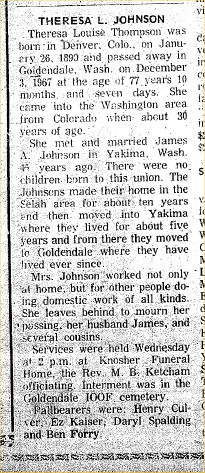
Back to Pioneer Photographs.
This page is maintained by M.D. Monk.

